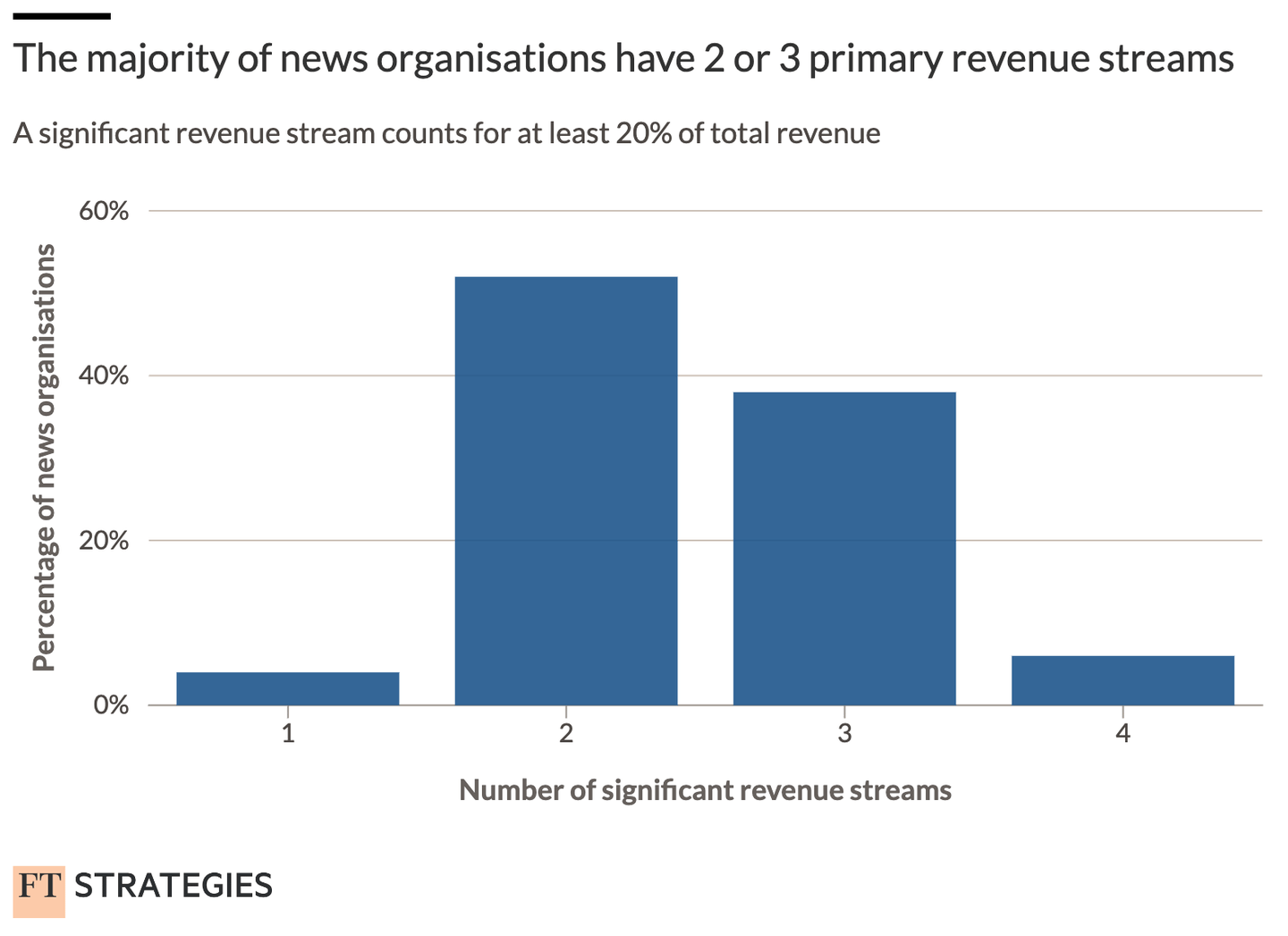-
George Montagu
One route to financial success for news organisations is diversification. By transitioning away from a single audience segment or single product, news organisations can mitigate the risk associated with “revenue concentration”, a situation where a significant portion of a company's revenue is dependent on a limited number of customers or a particular product line (for the purposes of this article, we define revenue concentration as having occurred when 50% or more of revenue is derived from a single source).
In this article, we reflect on findings from our new report on revenue diversification as well as the News Sustainability Project — an industry research project involving detailed data from 450+ publishers — to provide a “state of the nation” view on this crucial topic. We’ve split our thinking into two parts. First, we’ll provide an assessment of what our research is telling us about how revenue diversification has evolved to date. Then, we’ll offer up some tactical advice on what this tells us about where the industry should go moving forward.
What do we know about revenue diversification in the news media?
General business wisdom dictates that diversification is a good risk reduction strategy: “Diversified companies can achieve trade-offs between total risk and return that are superior to the trade-offs available to single-business companies” (Harvard Business Review, 1978).
On the surface, news organisations tend to appear quite well diversified already: our research tells us that 72% of organisations have avoided revenue concentration and that news organisations with three or four primary revenue streams (of 20% or more) are more profitable and more sustainable than those with just one or two. Theoretically, it follows that news organisations would be well-positioned against financial shocks. However, those of us within the industry know this is not the case, given the high levels of interdependencies that exist among these streams.
Put simply, legacy print publishers might think they have successfully diversified by growing digital revenues alongside print but in reality they remain exposed either to risks that are almost impossible to mitigate in the structural decline of print (print makes up 54% of revenue for legacy publishers), or emerging risks such as open-marketplace programmatic, or both.

The majority of news organisations currently have 2 or 3 primary revenue streams that contribute at least 20% to total revenue.
Attempts to diversify away from print currently rely overwhelmingly on growing digital advertising and subscriptions
The news organisations that participated in our research anticipate a reduced reliance on print revenue over the next three years, with the expectation that print’s contribution to the overall revenue mix will shrink from 54% to 43%. While this is partly a byproduct of the reality that print is in structural decline, it is also the result of a purposeful strategic shift toward digital subscriptions and digital advertising that we’re seeing across the industry.
When it comes to more emergent revenue sources for news organisations, such as events and e-Commerce, there is little evidence right now to suggest that these will significantly displace the more traditional forms anytime soon. In fact, our data shows that emerging revenue sources currently make up 16% of the revenue mix for publishers, and those surveyed anticipate that number will marginally reduce over the next 3 years to 15%.

Traditional revenue sources such as digital ads and subscriptions are expected to increase in future, while print is expected to go down.
But more radical diversification initiatives, although smaller in revenue terms, can provide crucial profit contributions for news organisations
Despite indications that emerging revenue sources will remain a small part (around 15%) of the overall mix, these can still be powerful contributors to the sustainability of a business. Indeed, these sources can be disproportionately meaningful when evaluated in profit rather than revenue terms. Given that the news business is often low (or no) margin, the possibility of generating 30%+ margins via events or eCommerce can represent significant opportunities for otherwise struggling players. Moreover, because they are genuinely different lines of business they are not vulnerable to the same risks (e.g. interdependencies) as more conventional diversification initiatives in digital media.
In our recent report on revenue diversification, we showcase a number of organisations where this dynamic is playing out. For example, Schibsted’s news media business represents 50% of revenue but has an EBITDA margin of just 7%; conversely, their Marketplaces business represents 31% of revenue but has an exceptional EBITDA margin of 39%! Although it is difficult to accurately calculate the exact profit contribution of each business based on the latest Schibsted annual report, one can assume that the Marketplaces business provides around 3x greater contribution than the News Media business and that these numbers had some bearing on Schibsted’s decision to separate these areas.

In low (or no) margin businesses such as news, the EBITDA margins of emerging revenue streams such as Marketplaces in Schibsted’s case can have positive contributions to the bottom line.
Overall, revenue diversification must be done carefully and strategically
While revenue diversification is an important practice in any business, it comes with some inherent risks: it can be difficult (and expensive) to execute, it can dilute your brand/value proposition and it can divert attention away from your core product or business unit. During our research, we heard anecdotal evidence about diversification leading to internal challenges. This is likely because these organisations are spreading their limited resources too thin or “trying to be everything to everybody” — a common pitfall when pursuing scale online. Morning Brew exemplifies a media organisation that has balanced expansion with focus. Although Morning Brew has transformed from a single newsletter in 2015 to a suite of multimedia properties today, it has done so while continuing to focus on growing and perfecting its advertising business via new formats and serving the North American audience, according to CEO of Morning Brew Austin Rief.
Diversification is important and can be a profit driver for organisations, but it needs to be pursued thoughtfully. Although there are challenges, there are also some practical steps that organisations can take to execute it successfully. To start off with, any diversification strategy ought to consider the target audience that an initiative is seeking to target and answer questions such as what their needs are and whether you’re in a position to meet those needs. Using some of the best practices and principles that we’ve outlined in detail our report, we hope that news organisations can build more resilient, profitable models that can withstand continual change of market dynamics.
In order to decide whether a diversification initiative is viable, we encourage you to start from the point of the view of the target audience and their needs.


.jpg?width=768&name=gettyimages-118386322_copy.jpg__1440x500_q90_crop_subsampling-2_upscale%20(1).jpg)
